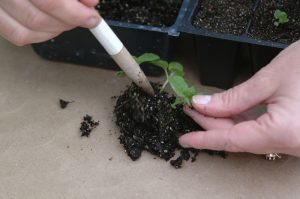Growing your own garden transplants from seed may take some extra work, but it does have its advantages.
You’ll have a much wider choice of species and cultivars since most garden centers have limited space and tend to carry primarily the plants that sell quickly. Rather than having to buy a dozen of one type of tomato when you only need one or two, you can grow just the amount of each plant you need. Or you can grow five flats of flowers all in the same color for that border garden you’ve been planning.
On the other hand, growing plants from seed does present some challenges, including finding enough space with the appropriate environment for healthy plants. They’ll need bright light, high humidity, warm – but not hot – temperature and good air circulation. If your space for plant production is limited, plan on buying the more commonly found plants from the garden center, and save the home production space for the special, hard-to-find items you can only obtain as seed.
Start with high-quality, fresh seed; look for the freshness date on the packet. Almost any container can be used for planting, as long as it is clean and allows excess water to drain out the bottom. Use a fine-textured, well-drained media, such as a peat moss-vermiculite mixture. Seeds need high relative humidity for good germination, so place a plastic bag around the container until seedlings are up and growing. Too much humidity also can be a problem, so poke a few holes in the plastic to allow ventilation.
Be sure to check your seedlings frequently for moisture needs. The planting media should be kept reasonably moist throughout the germination period. Water gently to avoid physically damaging the tender seedlings. Once plants are up and growing, allow the media to dry slightly between waterings.
Most home growers get into trouble after the seeds come up by not supplying the plants with enough light. Low light causes plants to become spindly and weak, so place them in as sunny a location as possible. Use artificial lights, if necessary.
Proper timing is crucial if you want the transplant to be the right size at planting time. Seeds of tomatoes, peppers and eggplant should be started about seven weeks before your outdoor planting date. Pumpkins, melons and squash should be started about four weeks before planting outdoors. Flower seeds will need anywhere from four to 14 weeks, depending on the species. Most seed packets have this type of information on the back.
For more information, see Purdue Extension Bulletin HO-14, Starting Seeds Indoors.

